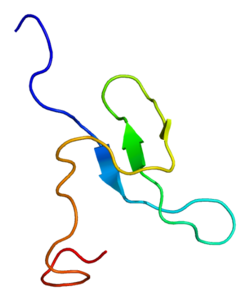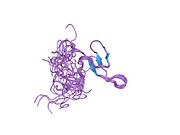Protein-coding gene in the species Homo sapiens
| WBP4 |
|---|
 |
| Available structures |
|---|
| PDB | Ortholog search: PDBe RCSB |
|---|
| List of PDB id codes |
|---|
2DK1, 2JXW |
|
|
| Identifiers |
|---|
| Aliases | WBP4, FBP21, WW domain binding protein 4 |
|---|
| External IDs | OMIM: 604981; MGI: 109568; HomoloGene: 38287; GeneCards: WBP4; OMA:WBP4 - orthologs |
|---|
| Gene location (Human) |
|---|
 | | Chr. | Chromosome 13 (human)[1] |
|---|
| | Band | 13q14.11 | Start | 41,061,509 bp[1] |
|---|
| End | 41,084,006 bp[1] |
|---|
|
| Gene location (Mouse) |
|---|
 | | Chr. | Chromosome 14 (mouse)[2] |
|---|
| | Band | 14|14 D3 | Start | 79,697,377 bp[2] |
|---|
| End | 79,718,960 bp[2] |
|---|
|
| RNA expression pattern |
|---|
| Bgee | | Human | Mouse (ortholog) |
|---|
| Top expressed in | - oocyte
- secondary oocyte
- amniotic fluid
- tendon
- biceps brachii
- Achilles tendon
- Skeletal muscle tissue of biceps brachii
- muscle of thigh
- gastrocnemius muscle
- vastus lateralis muscle
|
| | Top expressed in | - spermatocyte
- Paneth cell
- endothelial cell of lymphatic vessel
- genital tubercle
- primitive streak
- tail of embryo
- dentate gyrus of hippocampal formation granule cell
- epithelium of lens
- hair follicle
- substantia nigra
|
| | More reference expression data |
|
|---|
| BioGPS | 

 | | More reference expression data |
|
|---|
|
| Gene ontology |
|---|
| Molecular function | - zinc ion binding
- proline-rich region binding
- protein binding
- metal ion binding
- nucleic acid binding
| | Cellular component | - nuclear speck
- spliceosomal complex
- nucleoplasm
- nucleus
- U2-type precatalytic spliceosome
| | Biological process | - mRNA cis splicing, via spliceosome
- mRNA processing
- RNA splicing
- mRNA splicing, via spliceosome
| | Sources:Amigo / QuickGO |
|
| Orthologs |
|---|
| Species | Human | Mouse |
|---|
| Entrez | | |
|---|
| Ensembl | | |
|---|
| UniProt | | |
|---|
| RefSeq (mRNA) | | |
|---|
| RefSeq (protein) | | |
|---|
| Location (UCSC) | Chr 13: 41.06 – 41.08 Mb | Chr 14: 79.7 – 79.72 Mb |
|---|
| PubMed search | [3] | [4] |
|---|
|
| Wikidata |
| View/Edit Human | View/Edit Mouse |
|
WW domain-binding protein 4 is a protein that in humans is encoded by the WBP4 gene.[5][6]
This gene encodes WW domain-containing binding protein 4. The WW domain represents a small and compact globular structure that interacts with proline-rich ligands. This encoded protein is a general spliceosomal protein that may play a role in cross-intron bridging of U1 and U2 snRNPs in the spliceosomal complex A.[6]
Bi-allelic variants in WBP4 are responsible of spliceosomopathies leading to developmental disorders. Symptoms include hypotonia, global developmental delay, severe intellectual disability, brain, musculoskeletal, and gastrointestinal abnormalities.[7] Note that mutations on RNU4-2 [ia] gene induce also spliceosomopathies leading to intellectual disability.[8]
References
- ^ a b c GRCh38: Ensembl release 89: ENSG00000120688 – Ensembl, May 2017
- ^ a b c GRCm38: Ensembl release 89: ENSMUSG00000022023 – Ensembl, May 2017
- ^ "Human PubMed Reference:". National Center for Biotechnology Information, U.S. National Library of Medicine.
- ^ "Mouse PubMed Reference:". National Center for Biotechnology Information, U.S. National Library of Medicine.
- ^ Bedford MT, Reed R, Leder P (Sep 1998). "WW domain-mediated interactions reveal a spliceosome-associated protein that binds a third class of proline-rich motif: the proline glycine and methionine-rich motif". Proc Natl Acad Sci U S A. 95 (18): 10602–7. Bibcode:1998PNAS...9510602B. doi:10.1073/pnas.95.18.10602. PMC 27941. PMID 9724750.
- ^ a b "Entrez Gene: WBP4 WW domain binding protein 4 (formin binding protein 21)".
- ^ Eden Engal, Kaisa Teele Oja, Reza Maroofian, Katrin Õunap, Maayan Salton, Hagar Mor-Shaked et al., "Bi-allelic loss-of-function variants in WBP4, encoding a spliceosome protein, result in a variable neurodevelopmental syndrome", AJHG (2023). doi:10.1016/j.ajhg.2023.10.013
- ^ Greene, D., Thys, C., Berry, I.R. et al., "Mutations in the U4 snRNA gene RNU4-2 cause one of the most prevalent monogenic neurodevelopmental disorders". Nat Med (2024). doi:10.1038/s41591-024-03085-5
Further reading
- Takahara T, Tasic B, Maniatis T, et al. (2005). "Delay in synthesis of the 3' splice site promotes trans-splicing of the preceding 5' splice site". Mol. Cell. 18 (2): 245–51. doi:10.1016/j.molcel.2005.03.018. PMID 15837427.
- Gerhard DS, Wagner L, Feingold EA, et al. (2004). "The status, quality, and expansion of the NIH full-length cDNA project: the Mammalian Gene Collection (MGC)". Genome Res. 14 (10B): 2121–7. doi:10.1101/gr.2596504. PMC 528928. PMID 15489334.
- Dunham A, Matthews LH, Burton J, et al. (2004). "The DNA sequence and analysis of human chromosome 13". Nature. 428 (6982): 522–8. Bibcode:2004Natur.428..522D. doi:10.1038/nature02379. PMC 2665288. PMID 15057823.
- Ota T, Suzuki Y, Nishikawa T, et al. (2004). "Complete sequencing and characterization of 21,243 full-length human cDNAs". Nat. Genet. 36 (1): 40–5. doi:10.1038/ng1285. PMID 14702039.
- Strausberg RL, Feingold EA, Grouse LH, et al. (2003). "Generation and initial analysis of more than 15,000 full-length human and mouse cDNA sequences". Proc. Natl. Acad. Sci. U.S.A. 99 (26): 16899–903. Bibcode:2002PNAS...9916899M. doi:10.1073/pnas.242603899. PMC 139241. PMID 12477932.
- Bedford MT, Frankel A, Yaffe MB, et al. (2000). "Arginine methylation inhibits the binding of proline-rich ligands to Src homology 3, but not WW, domains". J. Biol. Chem. 275 (21): 16030–6. doi:10.1074/jbc.M909368199. PMID 10748127.
- Chan DC, Bedford MT, Leder P (1996). "Formin binding proteins bear WWP/WW domains that bind proline-rich peptides and functionally resemble SH3 domains". EMBO J. 15 (5): 1045–54. doi:10.1002/j.1460-2075.1996.tb00442.x. PMC 450002. PMID 8605874.
 | This article on a gene on human chromosome 13 is a stub. You can help Wikipedia by expanding it. |

 2dk1: Solution structure of WW domain in WW domain binding protein 4 (WBP-4)
2dk1: Solution structure of WW domain in WW domain binding protein 4 (WBP-4)




















 WBP4
WBP4